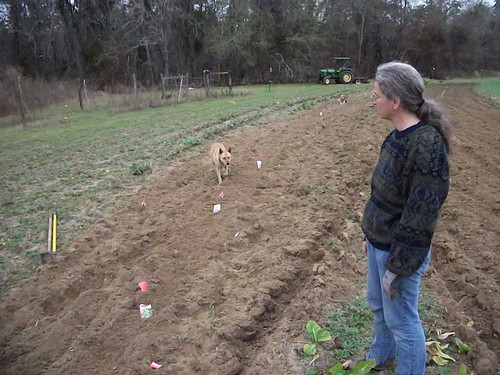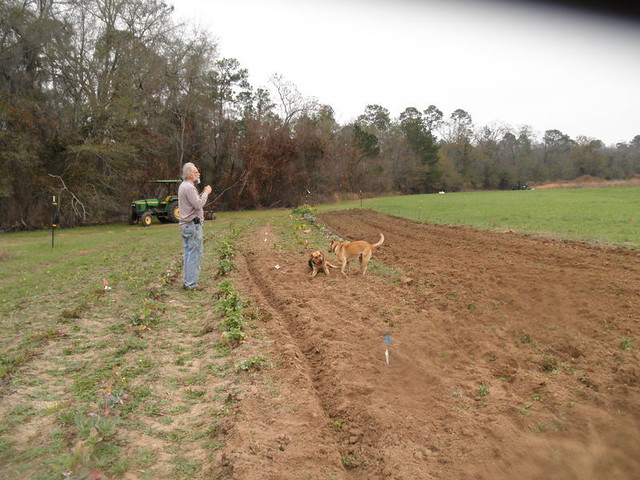Panning around their habitat, you can’t see them, but you can hear them.
Here’s a playlist: Continue reading
Panning around their habitat, you can’t see them, but you can hear them.
Here’s a playlist: Continue reading
A small lily that grows only in counties along the Georgia-Florida border, and maybe in a few in Alabama: Treat’s Rain Lily, Zephyranthes atamasca var. treateiae. These days it’s classified as an amaryllis.
-jsq
Here’s a slideshow: Continue reading

by John S. Quarterman, Lowndes County, Georgia, 6 February 2012.
Not digging, she hopes? We just planted potatoes there! Here’s a slideshow: Continue reading
 Back in December
Back in December
 we burned some planted longleaf.
Six weeks later, they’re greening up and candling.
I couldn’t find a single longleaf that didn’t survive.
Even ones that a few weeks ago you would have thought
were burnt sticks now have green leaves or white candles
or both.
we burned some planted longleaf.
Six weeks later, they’re greening up and candling.
I couldn’t find a single longleaf that didn’t survive.
Even ones that a few weeks ago you would have thought
were burnt sticks now have green leaves or white candles
or both.
Here’s a slideshow.
Pictures by John S. Quarterman 29 February 2012.
-jsq


 Fortunately these vines were mostly in
invasive exotics anyway
(chinaberry, mimosa, Japanese privet) that had grown up along the field edge.
After a few minutes,
here’s the result.
Fortunately these vines were mostly in
invasive exotics anyway
(chinaberry, mimosa, Japanese privet) that had grown up along the field edge.
After a few minutes,
here’s the result.
Most of the rest of the woods burned much more evenly, with flames only a foot or two above the ground.
Michelle Schoffro Cook wrote for care2 1 February 2012, Monsanto Wins Worst Company of 2011 Award,
The article gives plenty of reasons, and that was even before the recent hard evidence that both Monsanto’s GM corn and Monsanto’s Roundup are toxic to humans.Natural Society has awarded Monsanto the Worst Company of 2011 award for its ongoing work to threaten human health and the environment. Currently responsible for 90 percent of all genetically-modified (GM) seed in the US, the biotechnology giant is also the leader in developing genetically-modified (GM) seeds and the resulting crops worldwide. But Monsanto is perhaps best known for its herbicide Roundup, which many experts link to soil damage and herbicide-resistant superweeds, not to mention potential health problems.
Why do people keep growing that stuff around here and spraying Roundup on it?
-jsq
“We were very much surprised by our findings. Until now, itThe toxicity of the corn itself may have been a surprise, but not that of Roundup:has been thought almost impossible for Bt proteins to be toxic to human cells. Now further investigations have to be conducted to find out how these toxins impact the cells and if combinatorial effects with other compounds in the food and feed chain have to be taken into account,” says Gilles-Eric Séralini from the University of Caen, who supervised the experiments. “In conclusion, these experiments show that the risks of Bt toxins and of Roundup have been underestimated.”
These findings are in accordance with several other investigations highlighting unexpected health risks associated with glyphosate preparations.Previous studies, including ones by Dr. Séralini, already showed exposure to glysophate (the active ingredient in Roundup) to be “a risk factor for developing Non-Hodgkin lymphoma”, and to be toxic to human umbilical, placental, and placental cells with a that “is far below agricultural recommendations and corresponds to low levels of residues in food or feed.” In Argentina, Prof. Andrés Carrasco has demonstrated birth defects in amphibians and there is increasing evidence of human birth defects.
Regarding Monsanto’s GM corn itself, we already knew it causes liver and kidney damage in rats (later reverified using Monsanto’s own data), and chickens fed feed including Monsanto corn show abnormal gene expression.
Now we have even more hard evidence of the toxicity of Monsanto’s GM corn and of Monsanto’s Roundup. The journal article is available through Wiley online.
-jsq
Dig, dogs, dig!

Lowndes County, Georgia, 6 February 2012.
Like this: Continue reading